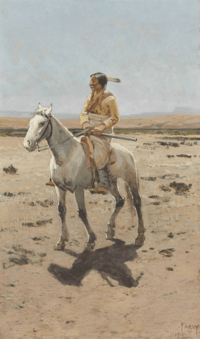American Ranch massacre facts for kids
Quick facts for kids American Ranch Massacre |
|||||||
|---|---|---|---|---|---|---|---|
| Part of the Colorado War | |||||||
 "Cheyenne Scout" by Henry F. Farny. |
|||||||
|
|||||||
| Belligerents | |||||||
| Cheyenne Sioux |
|||||||
| Commanders and leaders | |||||||
| N/A | unknown | ||||||
| Strength | |||||||
|
3 civilians |
~100 warriors | ||||||
| Casualties and losses | |||||||
| 7 killed 1 wounded 3 captured |
3 killed | ||||||
|
|||||||
The "American Ranch Massacre" happened in 1865 during the Colorado War. Cheyenne and Sioux warriors attacked a ranch near what is now Sterling, Colorado. During this attack, they killed the men at the ranch and captured three people.
Contents
The American Ranch Attack
In the winter of 1865, Lakota Sioux and Cheyenne groups were active in the Colorado Eastern Plains. On January 14, they attacked American Ranch. This ranch was about thirteen miles up the South Platte River.
Morning Skirmish
That morning, two ranch workers, Gus Hall and Big Steve, were crossing the South Platte River. They were going to cut wood. Suddenly, about 100 Native American warriors on horseback appeared. A small fight began. Big Steve was killed. Gus Hall was shot in the ankle. He had to defend himself from a sandy area by the river.
Some warriors stayed to fight Hall. The rest of the group went to American Ranch.
Attack on the Ranch
At the ranch were Bill Morris, his wife Sarah, and their two young boys. Five other ranch workers were also there. The Cheyenne and Lakota warriors charged in, shooting. They quickly set the ranch buildings on fire. This forced the ranch workers out into the open, where they were killed.
Sarah Morris and her two young boys were captured. One of the boys later died while they were held captive.
Gus Hall watched the attack from across the river. Because of his injury, he could not help. A warrior snuck up behind Hall. He shot an arrow that cut Hall's chest. Hall then shot and killed the warrior with his revolver.
Gus Hall's Survival
After the attack, the Native American groups moved on to continue their raids. Gus Hall, despite his wounds, had to walk twelve miles down the river. He was heading to Wisconsin Ranch. This ranch had also been attacked during the war.
Hall was injured in his foot and chest. He managed to survive the cold journey. He eventually told his story to the United States Army. The Army arrived at Wisconsin Ranch soon after.
Images for kids


